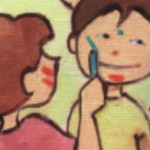 The book can inspire a host of art projects, from making African style masks to musical instruments to beads. The children in Jumping Jenny contributed to the fundraising fair in all different ways. One of the fun things that they did was make beaded jewelry. Uganda has a tradition of making beautiful beads out of magazines called Mzuri beads. These are fun to make and with some advanced planning, you can even control the color schemes by paying attention to the prominent colors of the magazine pages you use. It is also a great way to recycle old magazines!
The book can inspire a host of art projects, from making African style masks to musical instruments to beads. The children in Jumping Jenny contributed to the fundraising fair in all different ways. One of the fun things that they did was make beaded jewelry. Uganda has a tradition of making beautiful beads out of magazines called Mzuri beads. These are fun to make and with some advanced planning, you can even control the color schemes by paying attention to the prominent colors of the magazine pages you use. It is also a great way to recycle old magazines!
A few weeks before you plan to do this project, ask parents to send in their old magazines. Depending on the amount of time you have, and the age of your class, you might want to prepare some of the magazine strips in advance. Make a number of beads beforehand so you have examples to show the class. If you have access to a computer, you can also print out photographs of the beads from some of the websites listed as additional resources below.
This project could also be an opportunity to talk about global poverty. Please see the section on global poverty for Related Links.
Jumping Jenny Art Extension Activity:
To create African beads similar to Mzuri beads in the style and technique of beads made and sold by Ugandan women.
Materials Checklist:
- old magazines and catalogs
- glue
- cup
- paint brush
- juice box straw or coffee stirrer
- string
- varnish (optional)
Directions:
1. Cut triangles from your paper approximately 2 inches or less across the bottom and about 10 inches tall. Each triangle will make one bead – about twenty beads will make a necklace, but it really depends on how long you want the necklaces to be. You might want to pre-cut the strips for your class. If you pay attention to the colors on the page you are using, you can somewhat control the color of the beads.
2. Place the triangle wrong side up (the side that you don’t want to show) on the table. Lay the straw along the wide end of the triangle.
3. Tightly roll the strip around the straw twice, starting with the widest side.
4. Put glue on the remainder of your triangular strip and continue to roll the paper evenly, until you reach the pointy end of the triangle.
5. To finish the bead, glue down the narrow end and hold it in place until the glue sets.
5. Slip bead off of the straw and let it dry for about an hour. You can continue to make as many beads as you like, by following steps 2-5.
6. String the beads on heavy thread, a shoe lace, laniard or wool. Remember to tie a knot at each end so the beads don’t slip off. Then tie the ends together and you’ve got a necklace.
7. If you want the beads to look shiny, you can use a non-toxic varnish. Follow the instructions on the bottle to allow enough time to dry.
Additional Resources:
http://www.mzuribeads.com/about-the-bead. This website site includes a video tutorial that shows how to make the beads a well as a store for buying them from Uganda.
http://www.beadforlife.org/ BeadforLife works to eradicate extreme poverty by creating bridges of understanding between impoverished Africans and concerned world citizens. The website includes curriculum materials about Global Poverty: How Youth Can Make a Difference
http://emberarts.com is another American organization that partners with women in Uganda, East Africa to create beautiful jewelry using recycled paper and plastic.
http://www.outreachuganda.org/Host_A_Party.htm includes information about how you can help the Ugandan Pit-tek Women increase their bead sales by hosting your own Bead Party.
http://www.ugandabeads.com/ All of the beads on this site are made from recycled paper by poverty stricken people in the displaced person camps of Kampala, Uganda. Site includes ideas for hosting bead parties and other fundraising activities.

